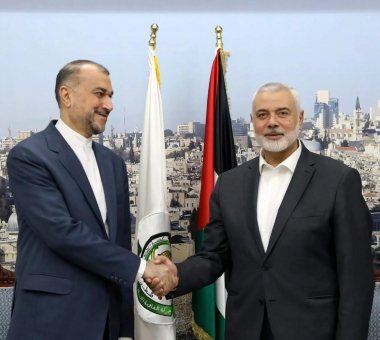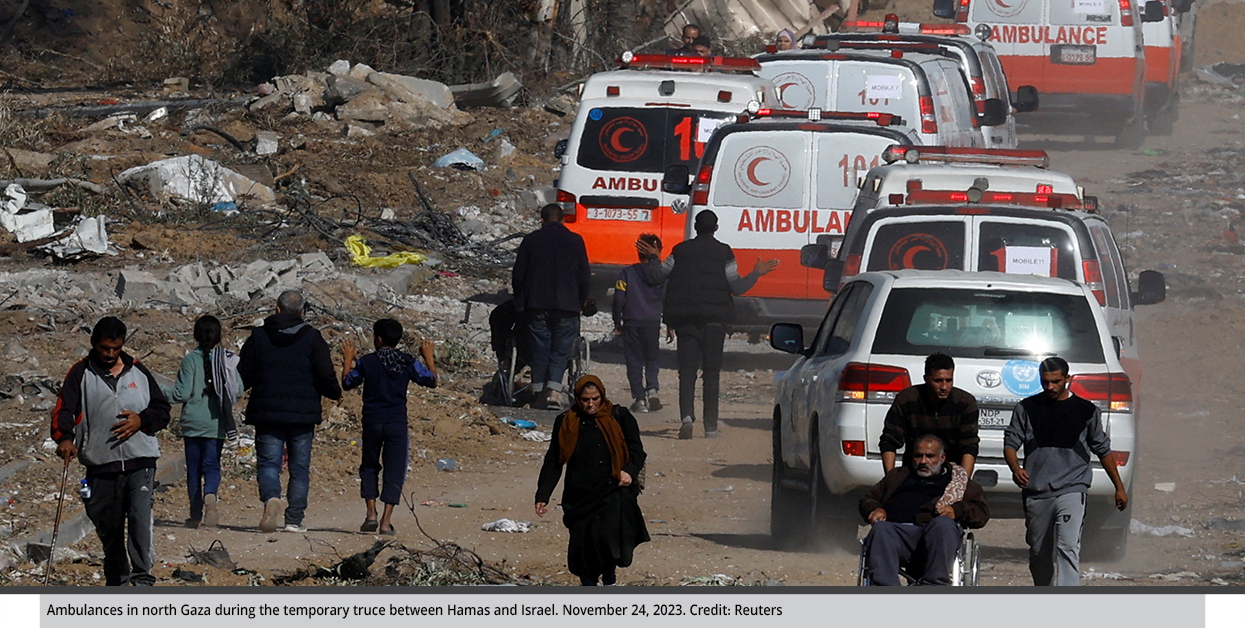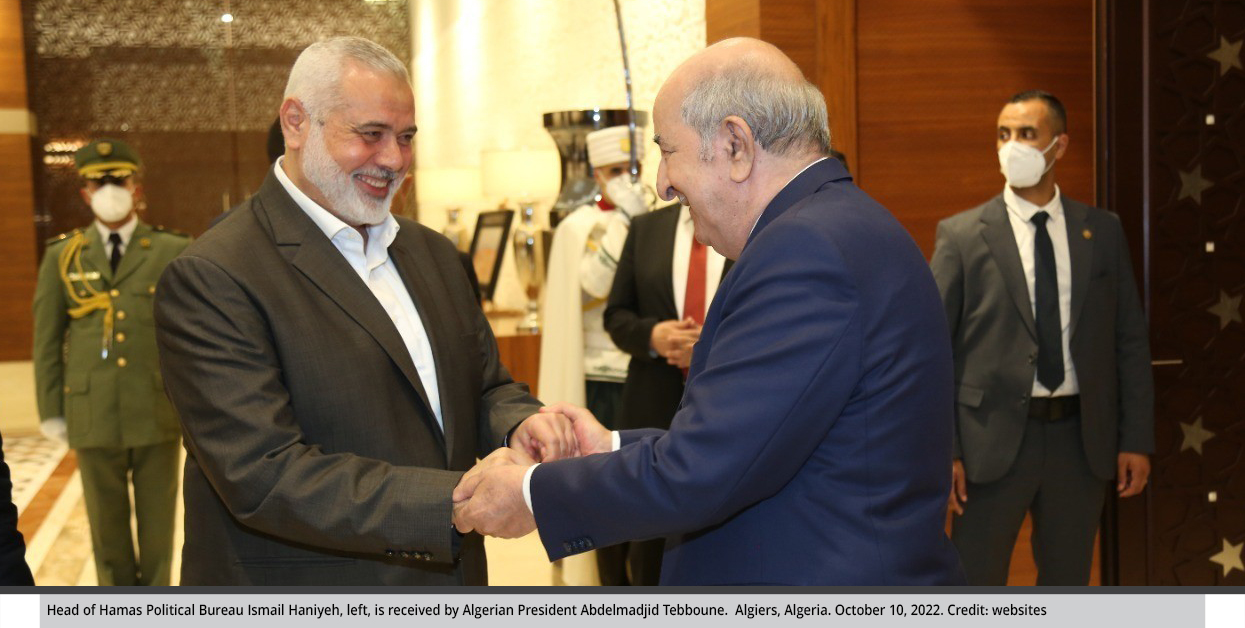The Paths of political Presence of Hamas Movement in Qatar
The choices of Hamas leaders to move from Qatar remain ambiguous and are limited to specific destinations: either Turkey, Iran, Lebanon, or Algeria. The question is: Which one is most likely—amd most preferred—to host Hamas leaders?
by STRATEGIECS Team
- Release Date – Apr 28, 2024

Recently, the debate about the future of the political presence of Hamas leaders in Qatar has escalated in a way that allows the belief that Hamas’s relocation to other countries is a possibility. This is especially true after the March 5 letter U.S. Secretary of State Anthony Blinken sent to Qatari Prime Minister and Foreign Minister Mohammed bin Abdulrahman Al Thani demanded that he threaten Hamas leaders with eviction from Qatar if they don’t move towards reaching a ceasefire agreement in the Gaza Strip.
The diplomatic relations between Qatar and both Israel and the United States have reached a critical point, prompting Doha to hint at re-evaluating its role in mediating between the Hamas and Israel. Since the attacks of the Palestinian factions on October 7, discussions have intensified regarding Doha’s ability to manage Hamas while preserving its diplomatic relations with America and Israel.
In light of the increasing indications that Doha is reconsidering its relations with Hamas, questions have escalated about the future presence of Hamas leaders in Qatar, and the options available to Hamas for relocation.
Qatar and Hamas: History of Relation and Mediation
The relationship between Qatar and Hamas began after Hamas won the majority of seats in the 2006 Palestinian legislative elections. As soon as Hamas took control of the Gaza Strip in 2007, these relations began to become official in the context of Qatar’s role in both reconstruction and the payment of salaries. The relations reached their peak in 2012 after the visit of the former Emir of Qatar, Hamad bin Khalifa Al Thani, to the Gaza Strip when it was under Hamas rule, and Doha’s hosting of the Hamas Political Bureau in the same year, a conference that convened many Hamas leaders, including the head of its Political Bureau, Ismail Haniyeh, and the head of Hamas abroad, Khaled Meshaal.
Meanwhile, many Middle Eastern states were active in mediating the Palestinian-Israeli conflict, including Egypt and Jordan. However, Qatar accumulated a record in mediating complex conflicts, including Yemen in 2008; Lebanon in 2008; Sudan in 2011, 2013, and 2017; the reconciliation between Djibouti and Eritrea in 2011; the negotiations between the United States and the Taliban movement; and the negotiations between the United States and Iran.
In this way, Doha has benefited from its relations with and its hosting of Hamas’s Political Bureau as Qatar began its mediation in the Palestinian-Israeli conflict. It has also benefitted from maintaining a low level of relations with Israel and the financial capacity it had to play an important role in the reconstruction operations of the Gaza Strip during post-wars periods, especially in 2014 and 2021. For this purpose, in 2012, Qatar established the Qatari Committee for the Reconstruction of the Gaza.
Qatar’s role in mediations involving Hamas expanded to include reconciliation between Hamas and Fatah after signing the “Doha Agreement” in February 2012. In August 2020, Doha also led mediation between Hamas and Israel to de-escalate conflict following protests near the border fence with Israel. And in May 2021, Qatar worked with Egypt, Jordan, and the United Nations to reach a ceasefire between Hamas and Israel.
However, the attacks by Palestinian factions on October 7 posed a challenge for Qatar, putting its role as a neutral mediator in regional conflicts at risk. Despite the success of Qatari, Egyptian, and American mediation in reaching a temporary truce on November 22, 2023, Qatar faced Israeli and American accusations of collusion in its financial and political support for Hamas. Among these were an accusation by Israeli Prime Minister Benjamin Netanyahu on January 24, 2024, that Qatar was funding Hamas and did not use its ability to pressure Hamas to release Israeli hostages in the Gaza Strip.
Meanwhile, the United States is demanding that Doha intensify its pressure on Hamas to agree to a temporary ceasefire agreement and the release of detainees. From the American perspective, Doha must clarify to Hamas the consequences of not making concessions, namely its relations with Qatar and the Qatari support provided to it. From this standpoint came Blinken’s demand to the Qatari foreign minister to threaten Hamas with expulsion if it continues to block progress toward releasing the hostages and establishing a temporary ceasefire. American Rep. Steny Hoyer underscored this demand on April 15 when he issued an official statement declaring, “If Qatar fails to apply this pressure, the United States must re-evaluate its relationship with Qatar".

These factors prompted Doha to hint that it would reconsider its role in mediation and perhaps redefine the nature of its engagement with the Palestinian cause. Qatar draws flexible lines in its relations with Hamas that can escalate or deescalate according to Qatar’s national interest, while at the same time maintaining the level of its relations with its regional and international allies.
Hamas in Qatar: Future Paths
In light of speculation about relocating Hamas leaders from Qatar to another country after Doha hosted them when Hamas’s Political Bureau departed Damascus in 2012 as a result of the Syrian crisis at that time, there is a need to assess the future paths for the presence of Hamas leaders, which are represented by three main paths: staying in Qatar, partial relocation, or total relocation. Each of these three options is associated with a set of determinants.
Path One: Staying in Qatar
The Political Bureau leaders of Hamas in Qatar, and Hamas’s maintenance of its current level of relations with it, are contingent upon Hamas showing flexibility in the terms of the ceasefire negotiations, the release of detainees, and the agreement to a ceasefire. This flexibility could reflect positively on reducing diplomatic pressures on Doha and strengthening its position following a successful previous mediation round on November 22, 2023, alongside Egypt and the United States.
On the other hand, this path is related to the post-war “day one” options, the role of Hamas in the future of the Gaza Strip, and the Palestinian cause in general. This path is reinforced if regional and international understandings are reached, maintaining a role for Hamas in managing the Gaza Strip or within the Palestinian political system.
This path is highly probable, given Qatar’s lack of direct announcement of its intention to relocate Hamas leaders or even hint at such a step. Besides, the reasons that necessitated Qatar’s hosting of Hamas—to mediate between Hamas, Israel, and the United States—are still present.
Moreover, the American suggestion to dismiss Hamas from Doha was presented as a means of pressuring Hamas rather than an absolute decision. This can be inferred from the statements of the Qatari Foreign Ministry spokesperson Majid Al-Ansari on April 23, 2024: “There is no justification for ending the presence of the Hamas [Political] Bureau in Doha while mediation efforts in the Gaza war continue, and Qatar remains committed to mediation but is reassessing its role".
Path Two: Partial Relocation
This path involves maintaining the minimum level of formal relations between Hamas and Doha by retaining some leaders who are either inactive or not directly accused of planning the October 7 attacks. This path is related to whether the pressures of mediators on Hamas fail to convince Hamas to give concessions that contribute to reach a ceasefire agreement. It is also associated with Hamas’s ability to maneuver and relocate part of its leadership to other Arab and non-Arab capitals.
This path is in line with the Hamas’s foreign policies in terms of distributing its leadership and bureaus across some capitals, thus avoiding dependence on any single state regardless of how close its ties are with that state. Hamas maintains official representative bureaus where several of its leaders are present in Turkey, Lebanon, Algeria, Iran, and Malaysia. Previously, it had bureaus in Sudan, Yemen, and Syria. This path is feasible, albeit to a lesser extent than the first path.
Path Three: Total Relocation
This includes the closure of Hamas bureaus in Qatar and the relocation of all its leaders to another destination. This path gains potential if ceasefire talks and the future of Hamas’s political role reach a dead end, making Hamas a burden on Doha that threatens Qatar’s relations with its allies, foremost among them the United States. This may push Doha to sever its relations with Hamas. In addition, certain capitals are ready to receive Hamas leaders, particularly its main leaders, such as Ismail Haniyeh, Khaled Mashal, and Mousa Abu Marzouk. So far, this path seems less likely than the previous two paths.

This path, if realized, requires looking for the available destinations Hamas would move to, which seem limited to some countries:
1- Algeria:
Algeria is considered a potential destination for the leaders of Hamas, as Hamas maintains good relations with the Algerian presidency, dating back to 2016. It has an official representation office, the responsibility of which is assumed by the Hamas leader, Mohammed Othman. In addition to the residence of the Hamas leader Sami Abu Zuhri in Algiers, Hamas maintains close relations with the Algerian Movement of Society for Peace, which is one of the branches of the Muslim Brotherhood.
2- Turkiye:
Hamas maintains close relations with the Justice and Development Party and, until now, has an official representation of Hamas. Some prominent figures of Hamas leaders in Turkiye, including the former Minister of Interior of Hamas and a member of its Political Bureau, Fathi Hammad. Despite Ankara’s reduction of its support for political Islam groups, its strict policy against their members associated with the Muslim Brotherhood, and the restricting their media channels, in addition to Turkiye’s preference for pragmatic politics regarding the war in the Gaza Strip, however, the loss of the Justice and Development Party in the recent local elections for reasons, including the Turkish presidency’s stance towards the war, may contribute to its attempts to review its position and agree on steps to restore the party’s popularity locally.
3- Lebanon:
An official representation of Hamas is present in Lebanon, where some of its important leaders are staying, including Osama Hamdan, Khalil Al-Hayya, and the former deputy head of its office, Saleh Al-Arouri, who was killed in an Israeli raid along with six other leaders of the Al-Qassam Brigades on January 2. In addition to the presence of military leadership and organizational bases for Hamas in the Palestinian camps, Hamas is closely linked with the Islamic Group (the Lebanese branch of the Muslim Brotherhood) and has a wide network of relations with Hezbollah. This makes Lebanon an acceptable option.
4- Iran:
The presence and official representation of Hamas in Iran dates back to the 1990s, with the former leader Imad Al-Alami at its helm. However, relocating Hamas to Tehran is not a preferred option for geographical and political reasons. Iran is not only geographically distant, its interests and influence could negatively affect Hamas’s policies in the future, despite the close political, military, and financial relations between Iran and Hamas.
In this context, the relocation of Hamas leaders to other countries is a highly complex issue due to Hamas’s failed attempts to reshape its relations with some Arab countries, as well as the refusal of some countries to host Hamas bureaus even in the pre-war phase. (News circulated about talks with Iraq to host the political office of Hamas, yet high-level Iraqi political sources specifically denied this to the Strategiecs Institute.)
In conclusion, all the aforementioned potential or excluded options and alternatives are governed by the acceleration of events and Hamas’s flexibility in dealing with developments, especially in light of the increasing probabilities of reaching a ceasefire agreement—thanks to Egyptian efforts and the visit of the head of Egyptian General Intelligence to Israel on April 26.
This visit came after notable statements by a member of the Hamas Political Bureau and its deputy head in Gaza, Khalil Al-Hayya, on April 25. His comments indicated that Hamas is ready to conclude a truce with Israel lasting five years or more. The truce involves Hamas’s agreement to lay down its arms and transform into a political party—if an independent Palestinian state is established within the 1967 borders.
Hamas will be granted more time if Al-Hayya’s statements are part of the political “equivocation” maneuvering. However, they will also establish a new phase if they truly express Hamas’s response to field, regional, and international pressures. Given the news suggesting a dialogue between Fatah and Hamas, this means that Hamas’s alternatives will shift towards the Palestinian territories in the West Bank and the Gaza Strip as a partner in the upcoming Palestinian political system in the long term. Meanwhile, many countries will be more prepared to receive Hamas’s leaders in the near term.

STRATEGIECS Team
Policy Analysis Team
 العربية
العربية